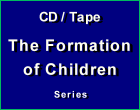Cultural Clash in Pictures
 |
 |
 |
 |
 |
 |
 |
The Damage a Revolutionary Century
Made in Customs

The California earthquake of April 18, 1906, ranks as one of the greatest natural disasters in our country. At 5:12 am, the San Francisco Bay Area felt a slight tremor. A minute later a legendary earthquake, 8.3 on the Richter scale, would leave parts of the city completely destroyed.
The quake epicenter was right in San Francisco and the damage was great. City Hall was destroyed and fires up to 2,000 degrees ravaged the city. Smoke could be seen for miles and miles. By nightfall, thousands of San Franciscans were fleeing the city, leaving behind their homes and most of their belongings.
There were a reported 3,000 deaths. Around 250,000 people were left homeless. Makeshift tent camps were erected in park areas and amid the burnt out ruins of city buildings. The family group pictured above poses for an impromptu photo at a tent camp set up on the ranch of John Daily south of the city – by the way, this was the first natural disaster of its magnitude to be captured by photography.
What is remarkable in this photo – as in the many others that recorded that disaster – is the clothing and natural dignity of the people. These persons were not aristocrats or upper class; just the regular people of San Francisco of the time.
A photographer appeared taking pictures of the earthquake shelters, and asked: “May I shoot a picture of your family?” The women quickly arranged their hair, the men put on their hats, but otherwise, this was how they normally appeared in daily life at the camp. They had very little, what they were able to carry out in their valises, but everything was ordered, calm, civilized – even in the hastily constructed tent camp.
Their faces were serious – they had just lost all their goods on this earth – but one sees no sign of despair or revolt on their physiognamies. You can see they did not give up, there were ready to restart from ground zero. The earthquake came; they gathered themselves together – with their single suit or dress – organized their lives, and prepared to go on, all the while maintaining their self-respect and decorum.
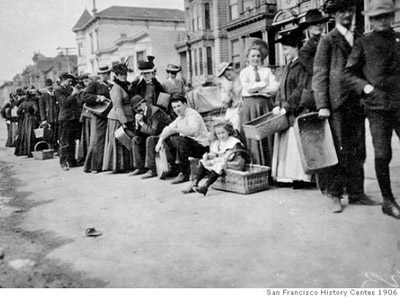
Foodline after the 1906 San Francisco earthquake; below, a couple searches the rubble
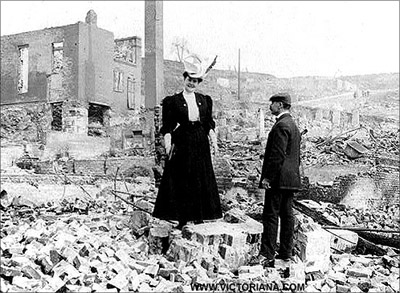
In the photo below it, a couple is out in the rubble looking at the remains of their house with the same general dignified conduct.
These simple people, the men in hats, suit jackets, white shirts and ties, the women in modest, elegant dresses and feathered hats, were better dressed than most traditionalist men and women today at Sunday Mass.
They reflect the good customs, modest dress and calm life that still remained in society at the turn of the 20th century.
Eleven years later, Our Lady of Fatima would warn Jacinta, "Certain fashions will be introduced that will gravely offend My Son."
People at that time had no notion of what kind of bad fashions and customs the Revolution would introduce after the World Wars. Nor could they imagine the general acceptation these immoral styles and vulgar ways of being would have in a world that was becoming increasingly secularized and pagan.

Above, victims of Hurricane Katrina in New Orleans in 2005; below, victims of a tornado in Oklahoma in 2013
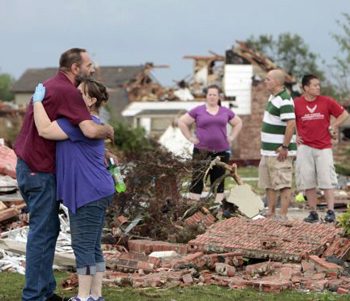
I am not denying here the human suffering of persons who lose their homes and belongings, which deserves sympathy in any century. Nor is it my aim to deny their need for assistance. I am simply comparing customs and clothing to emphasize the change that has taken place in a century, resulting in a human type that almost seems a different species than the man and woman of the early 20th century.
For example, in the first picture at right, you see one family – like so many others – who lost their home in Hurricane Katrina in New Orleans in 2005. The clothing they saved can hardly be called that – shorts, t-shirts, tennis shoes – the unrefined uniform of the 21st century man. Nor is there any care to present themselves in a dignified and gentile way, still a strong concern for the 1906 family.
In the second picture, we see a couple standing amidst the rubble of their house destroyed by a tornado that swept through Oklahoma in 2013. Today’s man revels in the pathos of tragedy, reflected in the perpetual public “hug,” an unimaginable pose for the San Francisco inhabitants of 1906. Then, there are the “big boy” onlookers in casual baggy shorts, clothing reserved for little boys in the past.
In the picture below left, you see persons who suffered losses in Tropical Storm Oscar in 2012, lined up to receive food supplies. No jackets or white shirts for the men, no skirts or modest blouses for the women. The typical dress of modern man has changed radically, all in the direction of egalitarianism and vulgarity.
The elderly woman, at right, lays on her bed in her FEMA trailer after Katrina. Her belongings are disorderly strewn around her; a half-eaten fast food meal sits on a side table. She shows her arms and legs without any concern for modesty, dignity or natural decorum.
Today we find customs and dress that reflect the loss of the discipline imposed by religion and civilization on daily life. They are the customs and dress of the victims of the 21st century pagan world.
The comparison of these sets of photos of disaster victims reveals, I believe, the enormity of the fall in civilization we Americans have experienced in the past century. It is the sad result of changing our customs to fit the increasingly demanding revolutionary myths.
If we continue on this path, where will we be in 50 more years?
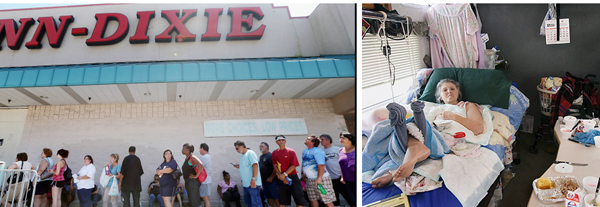

Posted August 1, 2014
______________________
______________________






